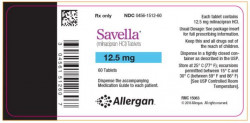Savella (milnacipran) Coupons, Discounts & Cost
Savella (milnacipran) is used in the treatment of fibromyalgia One way to save money on the Savella retail cost regardless of income and insurance status is to use Savella coupons or discount cards from RXCoupons. Use this Milnacipran coupon at this online pharmacy and receive up to 75% off the sale price.
What should I know about Savella?
Savella (milnacipran) is used in the treatment of fibromyalgia (chronic condition that can cause pain, stiffness, fatigue and difficulty falling asleep). Milnacipran, which is widely used as an antidepressant, is also approved by the FDA for the treatment of fibromyalgia. Milnacipran works by increasing the amount of serotonin and noradrenaline. These natural substances help stop pain signals in the brain.
Fibromyalgia is a chronic pain syndrome (lasting more than 3 months in various parts of the body). In addition, fibromyalgia is associated with fatigue, lack of sleep, depression, anxiety and cognitive impairment. Fibromyalgia is more common in women. As with other chronic pain syndromes, fibromyalgia is associated with disturbances in the peripheral and central nervous system (CNS), as well as disorders of the autonomic nervous system and the hypothalamic-pituitary-adrenal system.
As for the treatment of fibromyalgia, tricyclic antidepressants (including Savella) are used in smaller dosages than in the treatment of depression. Savella will help relieve fatigue, reduce pain in muscles, as well as improve sleep.
After oral ingestion, up to 85% of milnacipran is absorbed in the gastrointestinal tract. The maximum concentration in the blood is achieved within 2 hours. The half-life period is 8 hours.
What are the main Savella contraindications?
The drug is not used in patients with hypersensitivity and benign prostatic hyperplasia. Avoid simultaneous administration with monoamine oxidase inhibitors, selective serotonin reuptake inhibitors, adrenaline, noradrenaline, clonidine, digoxin, moclobemide. The drug is not used in patients up to 18 years of age.
Savella is recommended with extreme caution in case of epilepsy, hypersensitivity.
What are the main Savella contraindications during pregnancy and lactation?
You should definitely not take Savella during pregnancy and lactation.
Savella dosage
The basic dose is 50 mg 2 times a day, in the morning.
The highest single dose: 50 mg.
The highest daily dose: 250 mg.
Patients with renal failure should reduce the dose. Alcohol is not allowed during therapy.
What are the possible side effects for Savella?
The most common set of side effects: itching, nausea, dizziness, anxiety, tremor, dysuria, hypertension, hypotension and tachycardia, mania, delirium. Milnacipran does not have a pronounced sedative effect, but it has a beneficial effect on sleep parameters in patients with depression (duration and quality).
Central and peripheral nervous system: anxiety, dizziness, rarely - headache, tremor.
Cardiovascular system: palpitation, hot flashes.
Digestive system: dry mouth, constipation, nausea, vomiting.
Dermatological reactions: hyperhidrosis, rash.
Urinary system: urinary retention.
Allergic reactions.
What are possible drug interaction signs?
The risk of serotonin syndrome, arterial hypertension, coronary artery spasm increases when using Savella simultaneously with non-selective inhibitors of monoamine oxidase (iproniazid), inhibitors of B-type monoamine oxidase (selegiline), sumatriptan, inhibitors of A-type monoamine oxidase (moclobemide, toloxaton).
Savella should not be mixed with alcohol.
The risk of arrhythmia and arterial hypertension increases in case of combination therapy with adrenaline and norepinephrine.
The risk of gastrointestinal bleeding increases when using Savella simultaneously with nonsteroidal anti-inflammatory drugs.
Savella reduces the hypotensive effect of clonidine. The drug may change the level of lithium in the blood.
Digoxin enhances hemodynamic disorders (when used together with Savella).
Savella precautions for admission
Milnacipran can be taken no earlier than two weeks after you have finished using monoamine oxidase inhibitors.
It is not recommended to drive during the treatment.

